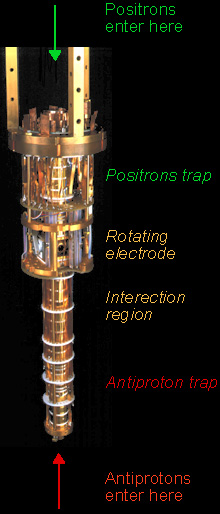


The ATRAP Penning trap
ATRAP (continued)
Antiprotons enter the trap apparatus from below, and are captured in the lower section. Here, they begin to oscillate and loose most of their energy in collisions with cold electrons, stored within.
They end up in the center of the lower region with a temperature that is also only 4 degrees above absolute zero.
Meanwhile, positrons from a radioactive source enter the trap from above and are accumulated in the upper section of the trap.
When cold antiprotons and cold positrons are ready, a mechanical valve that separates the lower and upper regions of the trap is opened, and the ingredients of cold antihydrogen are allowed to interact.
Whenever an antiatom is formed, it is no longer trapped in the Penning trap (its electric charge is zero!), so it drifts to the walls of the trap and annihilates, giving (with a definite signature) the proof of its existence.
Of course, an immediate annihilation is of not use for precise measurements! Once this initial, but crucial, step of the procedure will be optimized, a new apparatus will replace the trap. It will include a magnetic trap, intended to capture the cold antihydrogen atoms and store them for the required time.
Only at this stage, laser spectroscopy studies will allow precise measurements of the antihydrogen proprieties.
If you whish to know more about the experiment, you can have a look at the ATRAP pages.
|
(ATRAP
- page 2 of 2)
< Prev | |
